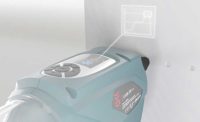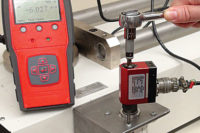During World War II, Rosie the Riveter did more than just inspire American women to support the war effort by joining the workforce. She also made the country aware of the importance of manual riveting to build a strong military and win WWII. Today, manufacturers like Airbus are equally aware of the importance of semi- and fully automatic riveting to build quality products and optimize production.
Airbus has been building the wing panels for the A320 family of aircraft at its assembly plant in Broughton, U.K., since 1997. The panels are assembled in workcells using low-voltage electromagnetic riveting (LVER) machines.
Each workcell consists of one machine and two wing panel fixtures. Made by Electroimpact, the machine installs slug rivets, stump-type lockbolts, lightweight grooved proportioned (LGP) collars, and flush-head temporary bolts in the top surface of the wing panels. The machine has separate fastening heads for the skin and stringer sides of the wing panel, which is vertically oriented in the fixture.
At the start of the process, the fastening heads clamp the panel assembly with up to 2,000 pounds of force to prevent component separation and interface burrs. Then, a shuttle table uses a spindle to drill the rivet hole, and a rivet is fed through tubing to the electromagnetic riveter.
The shuttle table inserts the rivet into the hole and measures its protrusion. If incorrect, the rivet is removed. If correct, the rivet is formed by the riveter, and the shuttle table mills the rivet head to the proper height (flush to +0.002 inch). Finally, the fastening heads unclamp, and the machine moves to the next fastener location.
For Airbus and other aerospace companies, machines like the LVER are essential. However, nonaerospace manufacturers need not make such a huge equipment investment to enjoy the benefits of semi- or fully automatic riveting. Whether installing blind rivets in cookware or solid rivets in furniture components, assemblers have numerous options for automating the process.
The Big Two
Both the automotive and aerospace industries have been early adopters of automatic riveting technology.
Fran Cyr, president and treasurer for National Rivet & Manufacturing Co., says the company introduced a semiautomatic riveting machine back in the early 1940s. The machine has long been used by both aerospace and auto manufacturers.
“Its basic operation hasn’t changed much in more than 70 years,” notes Cyr. “The operator loads the assembly parts and activates the machine by either pressing a button or using a foot switch. Riveting takes one-third of a second, and the worker removes the finished part.”
From the mid-1940s to the late 1960s, the auto industry’s use of semiautomatic riveting remained minimal, mainly for door hinges and latching assemblies. It increased somewhat with the arrival of robots in plants in the early 1970s to keep up with production. But, it’s real growth phase—including the use of fully automated riveting—began in the mid-1980s.
Some 30 years later, automakers rely on semi- or fully automatic riveting to assemble seating components, brake shoes and linings, door hinges, and floor and hood latches. More-complicated products include transmission carriers, door and hood strikers (joining the striker wire to a mating plate), torque converters and ball studs (joining the ball stud to a mating plate).
“The auto industry’s huge boom in the mid-1990s really required them to automate their riveting processes,” says Chuck Rupprecht, vice president and general manager for BalTec Corp. “Often, riveting of simple parts like a cigarette lighter can be fully automated. More-specialized assemblies like seating mechanisms and latching mechanisms for doors are more challenging for fully automated riveting. Many of these parts are moving on conveyors or indexers where riveting is done at one of the stations and assembly functions are often completed at other stations.”
Automated riveting began to take hold in the aerospace industry in the early 1990s. Since then, manufacturers have increasingly automated their riveting processes when assembling the fuselage and wing panels.
Last July, Boeing introduced an automated drilling and riveting process for the fuselage of the 777. The company expects the process to cut assembly flow time by almost half. For the past several years, Airbus has had robots install more than 3,000 blind rivets in each wing of the A330 airliner.
Transition Challenges
Making the switch from manual to automated riveting often presents several challenges to manufacturers. Two of the most common, according to Kyle Lang, sales director for Gage Bilt Inc., are maintaining high-enough production levels and having enough floor space on the assembly line for the equipment. Companies also need to be realistic about equipment ROI. Sometimes it may take a few years, rather than several months, for the machines to pay for themselves.
“When a manufacturer switches from fully manual to fully automated riveting, part fixturing is often a greater challenge than the actual riveting,” claims Rupprecht. “In the manual process, the operator clamped the parts, placed the rivet and maybe even did a little lubricating of the rivet or part assembly prior to forming. Now, the fully automated system must do all of these process steps.”
Later this month, BalTec plans to finish installation of a six-station, semiautomatic riveting system for a Tier 1supplier of a truck transmission component. The component is a metal ring that improves fuel efficiency and ease of shifting. Rupprecht says the system replaces three single-operator manual stations.
Until now, the operator positioned three pins in a fixture, mounted the component on the pins, and activated a pneumatic press to push in the pins to a preset depth. The component was then mounted on an indexer, indexed three times beneath a radial riveter (that forms each pin) and removed by the operator.
With the new system, the operator will still load the pins and component before riveting, and remove the finished assembly. However, BalTec has automated all press- and riveting-related functions, and included a vision system for part verification. Cycle time is about 45 seconds, and the system will run two 8-hour shifts, five days a week.
Another challenge is switching from a single-rivet machine to one that installs multiple rivets to increase productivity. Bob Wood, president of ECI Spinnomatic LLC, says a Tier 1 supplier of parking-brake levers successfully made the switch several years ago. The company uses a three-spindle head orbital riveting machine to form three rivets on one part, rather than three machines that each form one rivet. Wood says the company has retooled the other two machines for riveting other parts.
Part geometry needs to be carefully addressed before switching to automated riveting, stresses Bryan Wright, vie president of sales for Orbitform. He says manufacturers need to ask: How easy is the part to automatically load and unload? For high-volume operations, loading problems can lead to an increased cycle time.
“Riveting different types of parts on the same automated machine can lead to quality issues if there’s no mechanism to properly identify which part is being riveted,” notes Wright. “One way to prevent problems is to use an RFID tagging system on the fixtures where the parts sit.”
A Range of Riveters
Automotive and aerospace manufacturers aren’t the only ones benefitting from automated riveting. Medical device manufacturers are also embracing the technology.
Manufacturers of surgical scissors, clamps, implants and endoscopic instruments often use the servo version of Orbitform powerheads in fully automated riveting systems for clean room compliance. This power head features technology that enables it to determine rivet length and continuously monitor its position relative to the rivet, resulting in very precise forming of rivet heads up to 0.75-inch diameter. A pneumatic version of the powerhead is also available.
The servo version of the M-500 powerhead offers a maximum downward force of 10,000 pounds at 100 psi, while the pneumatic version offers 4,400 pounds at 100 psi. Both models have a 2.5-inch maximum stroke, which can be manually adjusted on the powerhead.
Process monitoring of an automated system ensures consistent riveting, even if the rivets vary in hardness—a common occurrence because they’re made by the millions. BalTec’s HPP25 process controller also improves the cost-effectiveness of riveting and assembled parts.
Rupprecht says the controller recognizes the start of the rivet after only 2 millimeters of form tool travel, eliminating the need for pressure or speed reduction during the riveting process. It offers 39 riveting modes and six control parameters: forming distance, riveting time, riveting force, spindle distance, external contact and rivet head height. All riveting data is displayed as curves on a graph, and can be exported and imported via USB and Ethernet interfaces.
Sometimes automated orbital riveting is used to form large-diameter rivets or tubular parts, notes Wood. These applications require a specialty three-roller-head assembly to form the part instead of a peen.
Since 2012, a Tier 1 supplier has used a custom orbital riveting system from ECI to form a tubular part. The semiautomatic system’s roller-head assembly forms the tube’s ID and then forms the tube’s OD. A separate process snaps a plastic clip into the tube. The clip has two wires that connect to a seat belt tensioner igniter.
Previously, the customer roll formed the tube’s OD with the plastic connector already snapped in place. This process was unrepeatable, often crushed the clip, and changed the tube’s final form, causing it to be out of tolerance.
Among the many tools offered by Gage Bilt is the GB8000, an automated unit that commercial and aerospace manufacturers use to feed and install a wide variety of structural and nonstructural blind rivets. Inline and pistol-grip-style models are available and feature a bowl feeder that holds 200 to 300 rivets. The low-maintenance machine is programmed based on the specifications of the blind rivet being installed.
In late 2013, a solar-panel manufacturer installed two customized GB8000s to speed up their panel-frame production. The units install a 0.25-inch, high-strength structural blind rivet every three to five seconds, depending on operator performance. Lang says the manufacturer’s cycle time has been cut in half.
A ladder manufacturer has also benefited from automatic riveting. National Rivet recently built a custom, four-headed hydraulic riveting machine that simultaneously sets four 0.1875-inch-diameter rivets. It also ensures consistent and accurate part production, says Cyr.
National Rivet modified its largest and most powerful riveter, the Model 3160, to include four hoppers, feed mechanisms, anvils and drivers. The machine also features a customized arm to accommodate the unusual shape of the ladder’s aluminum rung.
“By setting four rivets at once, the customer gets a better-looking, higher-quality product at a lower cost,” notes Kevin Klapperich, machine division manager for National Rivet. “What’s not to like?”








